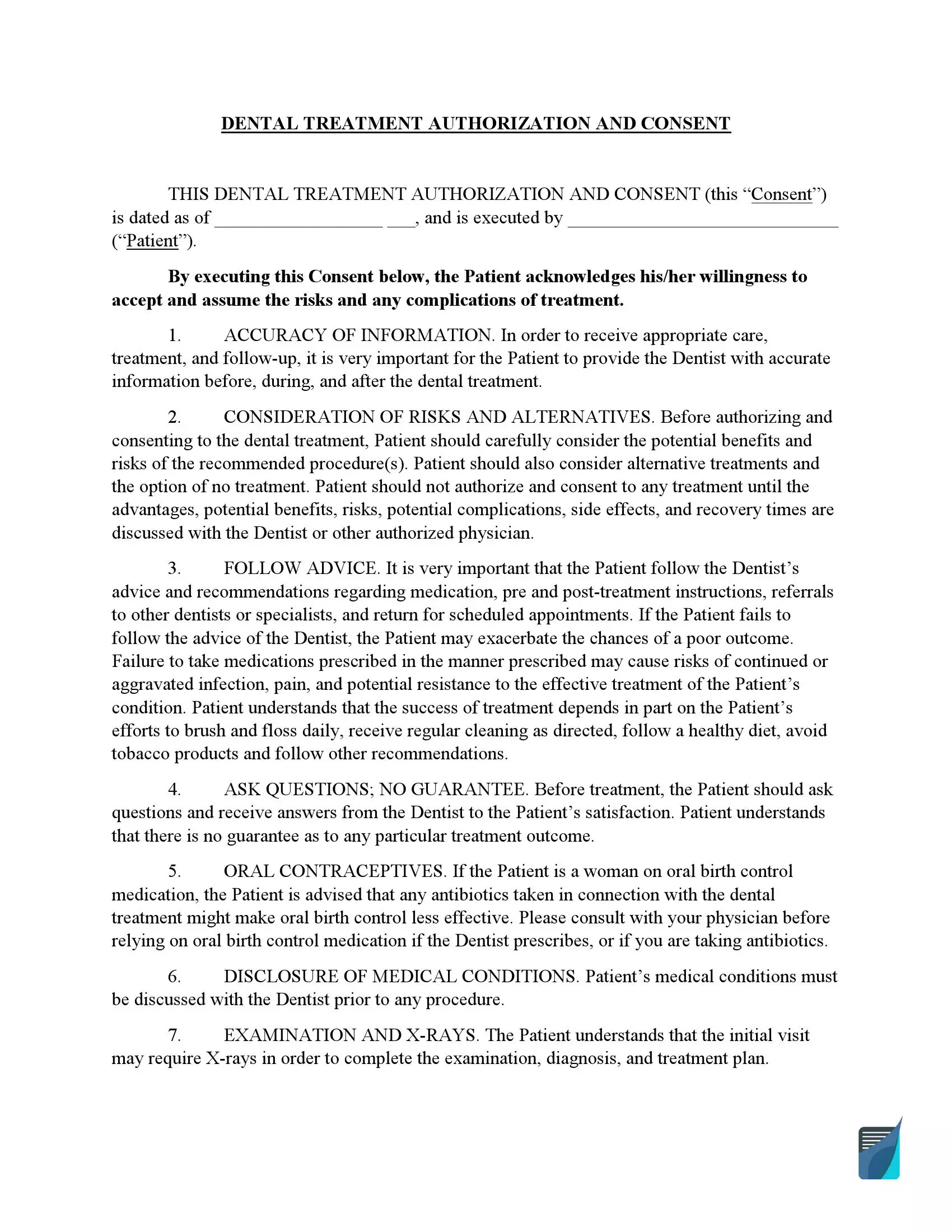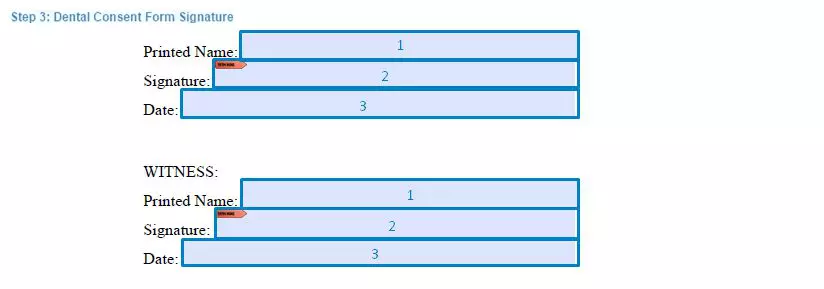Dental Consent Form
A vast number of procedures performed by a dentist can be regarded as invasive, as even a slight incise in the tissue can bring negative aftereffects to the mouth, including dentition or TMJ stability. Even the most experienced practitioner can not guarantee the complete safety of invasive procedures.
Any patient has the unconditional right to receive complete and comprehensive information about their oral health and the possible risks of undergoing the treatment. This is why informed consent is so commonly used in dentistry.

Build Your Document
Answer a few simple questions to make your document in minutes
Save and Print
Save progress and finish on any device, download and print anytime
Sign and Use
Your valid, lawyer-approved document is ready
What is Informed Consent in Dentistry?
A dental informed consent form is a written document confirming that the patient received all required information regarding their medical condition, the possible treatment options, and complications that may follow. One of the specific informed consent forms consists of two main parts: verbal communication and the written informed consent that documents the results of the dialogue and the patient’s acknowledgment.
The dental consent may be general and contain all possible risks and procedures the patient may undergo during the treatment process or be specific to the type of treatment plan assigned to a patient. Informed consent must be performed every time the patient is about to receive treatment or procedure. Besides, informed consent form needs to be signed before performing any procedures or treatments.
Root Canal Consent Form – used by dental professionals to ensure that their patients are properly informed about the procedure and their rights. The form contains important information about the procedure, alternatives, risks, and benefits.
What Are the Types of the Informed Consent?
A moral and professional code requires the dentist to educate their patients about the condition of their dental health, what procedures to undergo and what risks may follow, recommended treatment. Generally, the practice recognizes three types of informed consent: implied, verbal, and written.
While implied and verbal informed consent doesn’t require the documentation of the direct agreement of the client to undergo procedures, they are expected for most diagnostic procedures that don’t require invasive operations.
When it comes to the written informed consent, it is crucial to talk with the patient and ensure that they understand and are capable of consent. The dental recommended treatment may incorporate high-risk operations with anesthesia or sedation and extensive interventions with possible unwanted side effects; thus, it is crucial to be direct with the patient about any possible complications.
The best practice is to explain all risks of the procedures verbally and then attest it with the written consent. Failing to accomplish any part of the consent process leaves the informed consent be considered unfinished.
When the dentist’s proposed treatment is complex, it is crucial to provide all the details and risks beforehand. The patient has time to consider the options and contact the dentist’s insurance company to evaluate what treatments and procedures can be covered.
Besides the general informed consent, the dentist is obliged to educate the patient regarding the procedures and their health state. It is the right of the patient to refuse to undergo the treatment; in this case, the dentist should prepare the consent refusal and explain the consequences of such actions.
Can a 16-year-old consent to dental treatment?
When the minor is about to undergo a dental procedure, in most cases, it requires parental consent and their presence. However, for the minor children above 16, having the properly written “Permission to Treat a Minor without a Parent/Guardian Present” will allow them to undergo a limited amount of procedures without a legal guardian, such as teeth cleanings and recall exams, and sealants.

Necessary Components Of The Informed Consent Forms for Dentistry
The dentist has the right to use online templates or create his own to use in practice. You can create one general form to describe the complexity of all procedures and their complication and create forms for individual procedures and all possible consequences.
If you create your form, you should consult with an attorney to comply with state law. You can use the general consent template available on our website. Filling it out is a relatively easy and uncomplicated process, while most possible scenarios are described. Here is how the process goes:
Step 1. Provide the full name and the date of the document
Start filling out the form by providing the patient with information.

Step 2. Make sure the patient is aware and capable of consenting to the following points
The patient must read through all clauses listed in the consent form. If there are any additional questions, they must be provided with the necessary time and opportunity to get all answers relating to the procedure, aftereffects, and proposed treatment.
This form includes the following clauses:
- Accuracy Of Information.
- Consideration Of Risks And Alternatives.
- Follow Advice.
- Ask Questions.
- Oral Contraceptives.
- Disclosure Of Medical Conditions.
- Examination And X-Rays.
- Drugs, Medication, And Sedation.
- Changes In Treatment Plan.
- Temporomandibular Joint Dysfunctions
- Fillings And Restorations.
- Removal Of Teeth (Extraction).
- Crowns, Bridges, Veneers, And Bonding.
- Periodontal Treatment.
The clauses’ primary intent is to cover and document the verbal instructions received through dialog between the patient and dentist. It includes necessary details of patient information such as allergies a current treatment that may decrease the effectiveness of the antibiotics (i.e., oral birth control medications).
Besides, the document lists all possible complications that may entail the procedures performed by the dentist regardless of the practitioner’s skills and expertise.

Step 3. Sign the informed consent
To release the dentist from liabilities and confirm that they acknowledge what the procedure implies, the patient needs to indicate their printed name and provide a hand-written signature.
Note that the informed consent needs to be completed in the presence of the witness, who must also provide their full name and signature and the date they witnessed the consent given.
